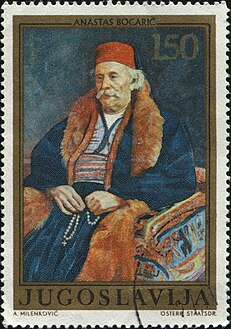Anastas Bocarić
This article contains close paraphrasing of non-free copyrighted sources. (September 2020) |


Anastas Bocarić (1 January 1864 – 17 April 1944) was a Serbian painter.[1][2]
Biography
He was from
In 1900 he participated in the Exposition Universelle or better known as the World Exhibition in Paris, representing the Kingdom of Serbia.[5] In the same year, he went to Istanbul to teach for the next five or six years. During this period, he designed the emblem of Ethiopia, which was in official use until 1975 and was commissioned for Emperor of Ethiopia Menelik II. From 1906 to 1908, he moved from Constantinople to Skopje where he continued to teach. In 1909 he ran the Balkan Art School in Thessaloniki. As of 1911 to 1932 he lived in Novi Sad and worked as a professor at the Women's School. Bocarić intensified his work on religious compositions and painted portraits of distinguished personalities living then in Vojvodina. In 1932 he settled in Perast where he continued to do what he preferred the most and that was painting portraits.[6] There he also collaborated with like-minded painters who identified themselves with the same group of academically-trained, artists from the region.[7]
He died in Perast in 1944.
Painting
At its core, Bocarić was a romantic, he found reality in the nature of the story, but in his paintings, he could find a foothold in contemporary solutions as well as in his Woman in White. Painting a slender figure in a peplos, with a mantle on her right shoulder, Bocarić, through decorative elements (carpet and curtains in the background, linear rhythms), experiences the art of French masters, perhaps most of Théodore Chassériau, a master of decorative style. Many of the portraits that Bocarić did in Mostar and in Sarajevo are a series of parade creations, often made from photographs.
Painting by Anastas Bocarić is really just a vestibule of Serbian modern art. Its true beginning can be accurately determined by the fact that zoographic painting pressed these spaces until the end of the nineteenth century.
-
Merchant Ivanisevic
-
Great People's Assembly of Serbs, Bunjevci and other Slavs in Banat, Bačka and Baranja, held in Novi Sad on November 25, 1918. The assembly proclaimed joining of Banat, Bačka and Baranja regions to the Kingdom of Serbia.
-
Destruction of the Serbian Empire on Kosovo 1389
See also
References
- ^ Basler, Đuro (1987). The Art treasures of Bosnia and Herzegovina. Svjetlost.
- ISBN 9780195170689.
- ISBN 9789940330033.
- ^ Mostar, Sarajevo (Bosnia and Hercegovina) Umjetnic̆ka galerija Ekspozitura; Mostar, Umjetnička galerija Bosne i Hercegovine Ekspozitura (1969). Umjetnička galerija Sarajevo Ekspoaitura Mostar (in Croatian). Umjetnička galerija.
- ISBN 9780880331319.
- ^ Review: Yugoslav Magazine. 1972.
- ^ Perović, Olga (1970). Art moderne du Monténégro (in French). Umjetnička galerija Socijalistička Republike Crne Gore.



